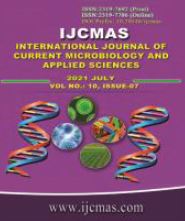


 National Academy of Agricultural Sciences (NAAS)
National Academy of Agricultural Sciences (NAAS)

|
PRINT ISSN : 2319-7692
Online ISSN : 2319-7706 Issues : 12 per year Publisher : Excellent Publishers Email : editorijcmas@gmail.com / submit@ijcmas.com Editor-in-chief: Dr.M.Prakash Index Copernicus ICV 2018: 95.39 NAAS RATING 2020: 5.38 |
Pre-eclampsia is one of the major causes of morbidity and mortality for both mother and baby.(1) Pre-eclampsia occurs in 3-11% of all pregnancies.(2) It is categorized into early onset and late onset according to the period of gestation. Pre-eclampsia that is diagnosed before 34 weeks of gestation is early onset and when diagnosed after 34 weeks of gestation is considered as late onset. To compare maternal and perinatal outcome in early onset (EOPE) and late onset pre-eclampsia (LOPE). This is a prospective observational study which included 177 pre-eclampsia patients, who were admitted in the Department of Obstetrics and Gynecology, Rangaraya Medical College at GGH, Kakinada, from SEP -2020 to FEB -2021 (6 months). Those who developed pre-eclampsia before 34 weeks of gestational age were identified and taken as early onset pre-eclampsia. those who developed after 34 weeks gestational age were identified as late onset pre-eclampsia. Maternal and perinatal outcome was compared between those groups. Incidence of pre-eclampsia is 3.3%, of which early onset (EOPE) is 1.3% and late onset pre-eclampsia 2%. Compared with late onset pre-eclampsia (LOPE), early onset pre-eclampsia (EOPE) group has higher rates of eclampsia (43.4% vs 27.7%), abruption placenta (14.4% vs 12%), pulmonary edema (1.4 % vs 0%) and there was no intergroup difference in the composite maternal outcome. A significantly higher number of women with early onset pre-eclampsia (EOPE) developed severe features during the disease course (73.9 % vs 60%) and most of them required treatment with antihypertensive drugs like labetalol (86.4 % vs 62.9 %), nifedipine (13% vs 37%) (P value 0.005). Babies born to mother with early onset pre-eclampsia (EOPE) had significantly higher rate of NICU admissions (50.7% vs 37%) and ventilator support (37.6% vs 25%). IUDs (20.2 % vs 8.3%) are significantly higher in number in early onset pre-eclampsia (EOPE). The study shows that women with early onset pre-eclampsia (EOPE) had more adverse maternal and perinatal outcomes than those with late onset pre-eclampsia (LOPE). But the difference was not statistically significant.
 |
 |
 |
 |
 |